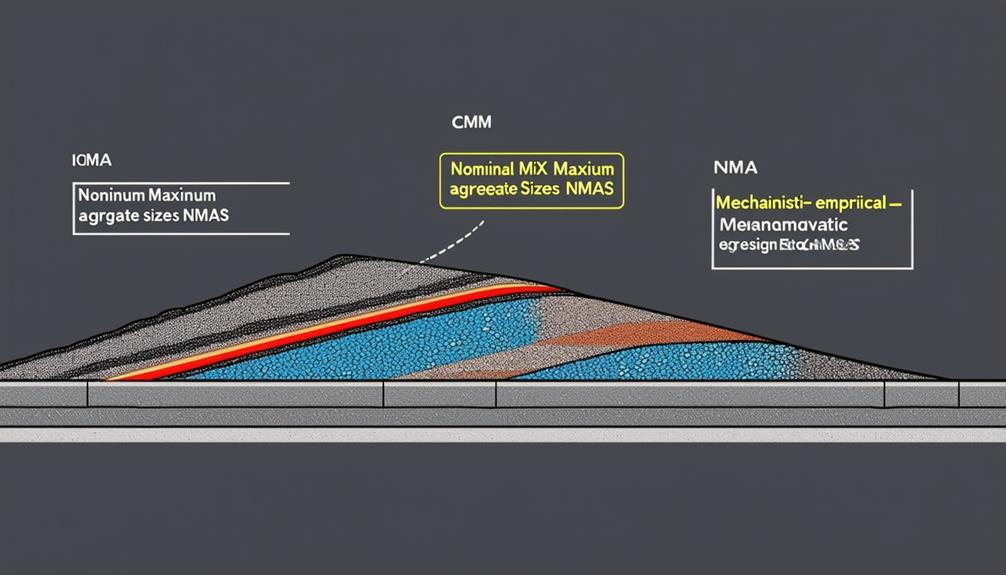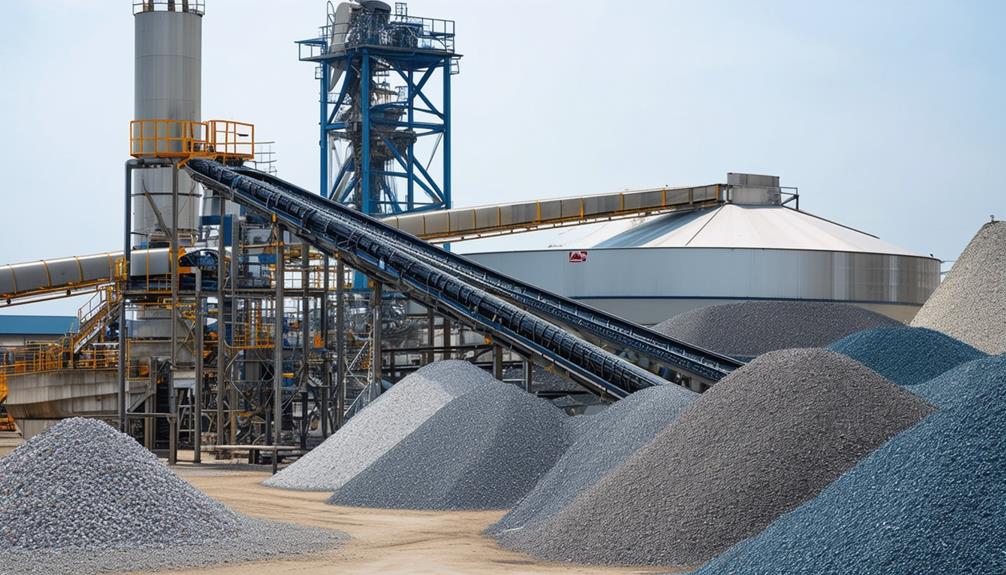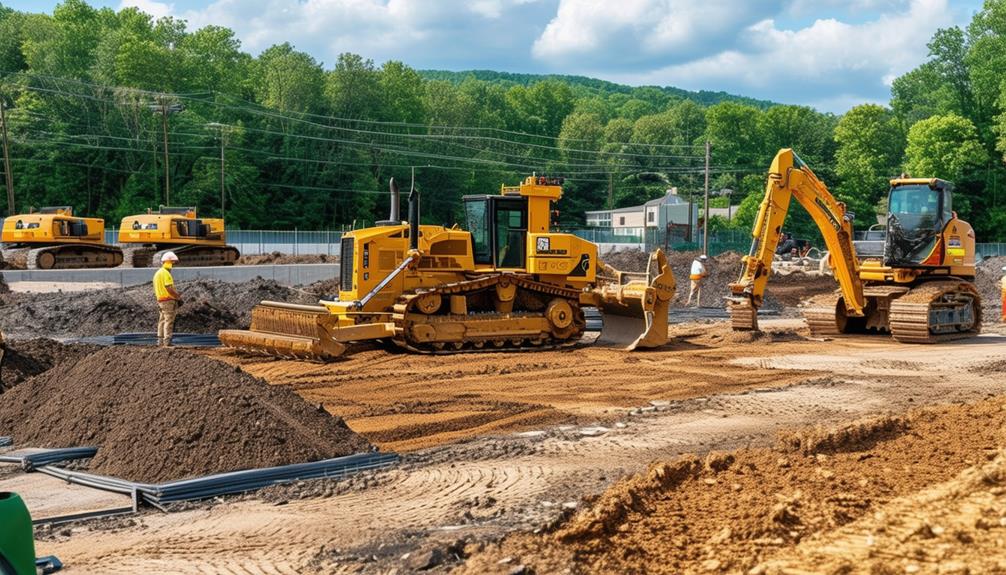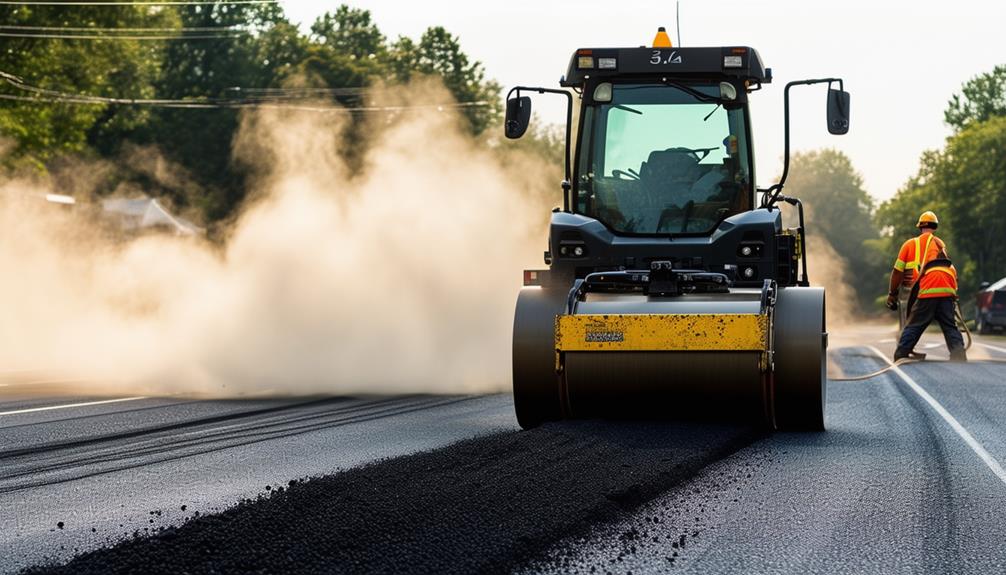The Role of Asphalt Mixtures in Paving Projects in Latham, NY
As a key player in the development of paving projects in Latham, NY, your expertise in refining the attributes of asphalt mixtures is vital. These mixtures are essential to the structural integrity and ecological sustainability of various infrastructure components such as roads, highways, and residential driveways.
To enhance the longevity and efficacy of these structures, employing perpetual pavements through the conversion method proves beneficial. This approach not only extends the service life of existing pavement but also minimizes material wastage.
Furthermore, the adoption of environmentally friendly asphalt solutions—including the use of recycled materials, warm mix asphalt techniques, and porous asphalt compositions—plays a significant role in promoting environmental conservation.
Investigating advanced design methodologies and implementing stringent quality control measures are critical steps to elevate the standards of your paving endeavors in Latham, NY.
Mechanistic-Empirical Pavement Design

To create optimal pavement structures, you turn to Mechanistic-Empirical Pavement Design (MEPD), an advanced approach that integrates empirical data with mechanistic principles. This powerful method ensures the construction of durable and cost-effective pavements that meet specific performance requirements. By focusing on both the physical causes of stresses—such as load and environmental factors—and observed pavement performance, you can better predict the behavior of your pavement under diverse traffic and environmental conditions. This knowledge equips you to select suitable materials and structural design elements to ensure the long-term sustainability and performance of your pavement.
To achieve the best results, you must consider several key factors. These include the material properties, layer thicknesses, and the projected traffic inputs, such as average vehicle weight and daily traffic volume. Additionally, incorporating the right environmental data, such as climate conditions and seasonal variations, is essential. This comprehensive approach helps prevent premature deterioration by identifying potential issues before they arise. It also enables practical and effective preventative maintenance strategies for municipal and national road networks.
For asphalt pavement projects in Latham, NY, using the Mechanistic-Empirical Pavement Design Guide (MEPDG) ensures not only the structural integrity of the pavement but also its smooth ride quality. The MEPDG further provides significant long-term benefits by optimizing the pavement design, which ultimately results in more efficient use of resources. By utilizing this advanced method, your paving projects are designed to remain in optimal condition, ensuring the safety and satisfaction of drivers and pedestrians alike.
Perpetual Pavements by Conversion

You'll now delve into the innovative method of Perpetual Pavements by Conversion, a strategy designed to enhance the longevity and functionality of existing pavement systems, thereby minimizing disruptions and reducing costs. This forward-thinking approach involves transforming current pavement structures into perpetual systems to ensure ongoing sustainability. By adopting this method, you'll contribute to maintaining infrastructure that isn't only durable and efficient but also cost-efficient over the extended period.
During this webinar, we'll explore the essential principles and tools required for converting existing pavements. Emphasis will be placed on effective maintenance and rehabilitation techniques that cause minimal inconvenience. This method is particularly focused on the astute utilization of resources, advocating for the repurposing of materials, diminishing waste levels, and safeguarding natural assets. Further, it aims to optimize maintenance practices to keep facilities such as car parks and roadways operational, all while reducing the ecological footprint.
Through a series of real-life case studies, the effectiveness of Perpetual Pavements by Conversion across diverse scenarios will be showcased. This strategy is inherently aligned with the collective quest for freedom and independence, ensuring that your paving initiatives remain sustainable and resilient, benefiting future generations.
Plant Operations for Quality Control

In managing HMA (Hot Mix Asphalt) plant operations for optimal quality control in Latham, NY, it's imperative to ensure efficient production and strict adherence to industry regulations and specifications to deliver superior-quality asphalt pavements. This is achieved by implementing precise calibration processes and meticulous verification procedures that ensure accurate material proportions and appropriate mixes. These crucial processes, when rigorously followed, significantly enhance the performance and extend the lifespan of the asphalt pavements.
In the context of HMA plant operations, calibration and verification are fundamental to comply with the rigorous standards and specifications set by the industry. Neglecting these procedures can result in inconsistent mixes that detrimentally impact the long-term functionality of the pavement. Hence, implementing robust quality control measures in plant operations is vital for fabricating durable and enduring asphalt pavements.
Besides the quality enhancement, efficient plant operations also yield substantial economic advantages by contributing to cost reductions and heightened construction efficiency.
Furthermore, diligent adherence to quality control protocols in plant operations is essential for ensuring the safety and sustainability of the construction projects. By guaranteeing precise and uniform production, stakeholders can be confident that their pavement projects will conform to the highest quality standards.
Jobsite Preparation Essentials

Prior to initiating the paving operation in Latham, NY, it's imperative to thoroughly prepare the jobsite by removing all forms of debris, conducting precise surveying and demarcation, and addressing underlying issues related to soil compaction and water drainage to mitigate typical construction obstacles.
The preparation of the site entails the elimination of foliage, barriers, and any extraneous materials that might disrupt the paving activities. This not only facilitates a more seamless construction workflow but also helps in circumventing any expensive setbacks or additional work later on.
Precise surveying and marking of the area are critical, as they determine the accurate pavement configuration and measurements. This phase establishes the groundwork for a successful undertaking, ensuring that the asphalt pavement is laid down precisely and efficiently.
Moreover, ensuring optimal soil compaction and grading are paramount to form a solid foundation for the asphalt. Proper drainage planning is equally imperative, as it prevents the accumulation of water which could undermine the structural integrity of the pavement.
Additionally, it's crucial to establish adequate access and implement traffic control strategies to safeguard both the workforce and the public throughout the duration of the project.
Efficient Pavement Design Tools

For efficient asphalt paving projects in Latham, NY, civil engineers utilize state-of-the-art design software like PAVExpress to enhance pavement thickness optimization and cost-effectiveness. This no-cost, web-based application streamlines the design process for both flexible and rigid pavements, conforming to the AASHTO 93/98 design guidelines. By leveraging PAVExpress, professionals can rapidly calculate the required pavement thickness for specific projects, ensuring a balance between structural integrity and financial efficiency.
PAVExpress includes an integrated feature, PaveInstruct, which provides comprehensive guidance, promoting accuracy and productivity in the design workflows. This digital tool elevates design precision and effectiveness for asphalt mixtures in paving initiatives, enabling engineers to devise tailored solutions that satisfy project requisites.
PAVExpress plays a pivotal role in promoting pavement sustainability, as it aids in developing robust pavements that reduce environmental footprints. Through strategic asphalt optimization and design adeptness, PAVExpress fosters the construction of pavements that aren't only resilient and cost-efficient but also environmentally considerate in Latham, NY.
Green Asphalt and LEED Credits

By integrating recycled materials such as reclaimed asphalt pavement (RAP) into asphalt formulations, companies can markedly lessen the environmental repercussions of their paving activities while obtaining valuable LEED (Leadership in Energy and Environmental Design) credits. This method promotes the conservation of finite resources and reduces the energy demand associated with production processes. Asphalt compositions that include RAP are pivotal in fostering sustainable building techniques. In the city of Latham, NY, employing such green asphalt technologies supports both local objectives and broader sustainable development goals.
The adoption of ecologically responsible methodologies in asphalt paving is a testament to a firm's dedication to sustainability. The LEED certification system provides recognition and incentives for these environmentally friendly practices. The asphalt sector, by increasingly utilizing recycled inputs, has positioned itself as a forefront runner in ecological stewardship. By incorporating these advanced practices, companies in the asphalt industry can significantly enhance the environmental sustainability of their projects.
Utilizing green asphalt in the urban context of Latham, NY, optimizes the environmental benefits by preserving natural assets and minimizing energy requirements during production. These sustainable practices align with both local and international environmental initiatives.
Hot Mix Asphalt Pavement Benefits

Hot mix asphalt pavements, a highly sought-after material for paving projects, provide a robust array of advantages that enhance both user experience and structural integrity. By choosing hot mix asphalt, you can benefit from durability that withstands the ravages of time. On average, these pavements boast a lifespan of 15-20 years, dramatically reducing the necessity for frequent repairs and replacements. This extended durability translates into cost-efficiency, as maintenance expenses are minimized.
A key feature of hot mix surfaces is their superior skid resistance. This attribute significantly enhances safety for motorists, making it an optimal selection for areas with heavy vehicular traffic. The material's flexibility allows it to conform effectively to freeze-thaw cycles and bear substantial loads, ensuring that it can withstand environmental challenges.
The list of benefits extends further. Hot mix asphalt also ensures a considerably smoother surface, which leads to lower noise emissions and a more pleasant driving experience. Because of these comprehensive advantages—spanning durability, safety, and comfort—hot mix asphalt is a favored choice for paving undertakings, offering a reliable and enjoyable driving environment for all users.
With its myriad of positive attributes, hot mix asphalt distinguishes itself as an exceptional choice in pavement solutions.
Sustainability in Road Construction

Incorporating environmentally responsible methods into your asphalt formulations can make a significant impact on decreasing ecological degradation in road construction initiatives. One effective strategy is the utilization of recycled components in the asphalt blend. This approach minimizes waste and conserves essential raw materials.
In the town of Latham, NY, sustainable road development practices include the implementation of these recycled elements to reduce the ecological footprint.
Another crucial element is the adoption of warm mix asphalt technologies. These advanced technologies decrease the need for high-temperature production, thereby reducing energy consumption and consequently diminishing greenhouse gas emissions. This not only aids in the protection of the environment but also curtails energy expenditures. Given the increasing urgency of addressing climate change, such initiatives are becoming increasingly critical.
Moreover, porous asphalt formulations are pivotal in eco-friendly road construction. By enabling water to infiltrate through the structure of the pavement, these formulations bolster stormwater management, curtailing runoff pollution and mitigating associated environmental hazards.
Frequently Asked Questions
What Is the Purpose of Asphalt Mix Design?
So you're curious about the essence of asphalt mix design? Consider it akin to constructing a robust foundation for your envisioned roadway. According to design specifications, asphalt mix design is a meticulous process that ensures the crafted mixture conforms to defined performance criteria.
This procedure entails selecting optimal materials capable of enduring vehicle traffic, adapting to climate variations, and resisting environmental pressures. By achieving this, the resulting pavement structure isn't only durable and resistant to defects such as rutting and cracking but also contributes to a smooth driving experience – epitomizing freedom on expanses of open road.
What Is the Importance of Asphalt in Road Construction?
As a paramount material in road construction, asphalt epitomizes durability and sustainability. This cost-effective and reliable choice not only ensures a smooth and safe driving experience but also excels in resistance to substantial traffic burdens and inclement climatic conditions.
Asphalt's advantages extend further, encompassing environmental sustainability and enhancing user safety, making it an indispensable selection for pavement undertakings. Thus, it guarantees that the infrastructure you utilize is dependable, efficient, and durable, serving as a fundamental component in the integrity and functionality of road systems.
What Is the Role of Asphalt Binders in a Pavement Structure?
Asphalt binders serve as a foundational element in pavement structures. These binders exhibit strong adhesive qualities that bind the aggregates, thereby boosting the structural integrity and durability of the pavement.
The overall performance and lifespan of the pavement are heavily influenced by the specific type and grade of asphalt binder employed. Selecting the appropriate binder is crucial for ensuring the pavement can withstand variations in temperature and resist degradation over time. Optimal binder selection leads to smoother driving experiences and reduces the demand for frequent maintenance.
Furthermore, the choice of mix design plays a pivotal role in extending the life of the pavement, making it essential to select these components with care.
What Is the Most Commonly Used Asphalt Mix?
In the realm of pavement construction, the most frequently utilized material is dense-graded hot mix asphalt (HMA), which is celebrated for its durable characteristics and flexible applications.
This formulation combines meticulously graded aggregates, an asphalt binder, and fillers, which collectively contribute to a seamless driving experience and economic efficiency.
Its proven performance under the stress of heavy traffic and diverse climatic conditions makes it a favored option among construction professionals and civil engineers.
Conclusion
As you prepare for your paving project in Latham, NY, it's crucial to acknowledge the pivotal role asphalt mixtures play in the project's outcome.
By selecting the appropriate blend of materials and employing strategic design methods, your venture can attain sustainability, enhanced longevity, and earn LEED (Leadership in Energy and Environmental Design) credits.
Implementing perpetual pavements and utilizing advanced design software to optimize the mixtures will help ensure a durable, eco-conscious infrastructure.
